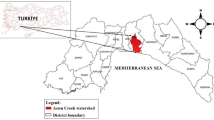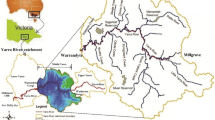Abstract
Uncertainty of best management practice (BMP) effectiveness is an important factor in the development of watershed management plans. This study explored the uncertainty of BMP effectiveness in reducing total nitrogen (TN) load owing to the uncertainty in hydrological parameters, thereby improving their reliability. A watershed model, annualized agricultural non-point source pollution (AnnAGNPS), was employed to evaluate the effectiveness of the four potentially feasible BMPs (i.e., riparian buffer, fertilization reduction, no-tillage, and parallel terraces) in the Shanmei Reservoir watershed, located in the southeastern coastal region of China. Annual and seasonal uncertainty variations in BMP effectiveness were evaluated based on ten parameter sets selected from 1000 parameter groups using Latin hypercube sampling. The results showed that the uncertainty of BMP effectiveness in reducing the TN load was larger than the uncertainty of TN load simulation at annual and seasonal time scales. The BMP effectiveness tended to be higher in summer than in the other seasons. The uncertainty of BMP effectiveness varied seasonally, and it was always lower in summer for most BMPs. This indicated that the impact of BMPs on reducing TN load was more effective, with a higher reduction rate and lower uncertainty in summer. Among the BMPs, the parallel terrace was the most effective measure for reducing TN load since it had the highest reduction rate and relatively low uncertainty. Although this study is a case study, it can provide a scientific reference for decision-making in uncertain situations when AnnAGNPS is applied for water quality simulations.




Similar content being viewed by others
References
Abdelwahab O, Bingner RL, Milillo F, Gentile F (2016) Evaluation of alternative management practices with the AnnAGNPS model in the Carapelle Watershed. Soil Sci 181(7):293–305. https://doi.org/10.1097/ss.0000000000000162
Arabi M, Frankenberger JR, Engel BA, Arnold JG (2008) Representation of agricultural conservation practices with SWAT. Hydrol Process 22(16):3042–3055. https://doi.org/10.1002/hyp.6890
Arabi M, Rao SG, Hantush MM (2007) A probabilistic approach for analysis of uncertainty in the evaluation of watershed management practices. J Hydrol 333(2–4):459–471. https://doi.org/10.1016/j.jhydrol.2006.09.012
Bai X, Shen W, Wang P, Chen X, He Y (2020) Response of Non-point Source Pollution Loads to Land Use Change under Different Precipitation Scenarios from a Future Perspective. Water Resour Manag 34:3987–4002. https://doi.org/10.1007/s11269-020-02626-0
Beven K (2006) A manifesto for the equifinality thesis. J Hydrol 320(1–2):18–36. https://doi.org/10.1016/j.jhydrol.2005.07.007
Bingner RL, Theurer FD, Yuan Y (2011) AnnAGNPS technical processes documentation, version 5.2. USDA-ARS National Sedimentation Laboratory
Bisantino T, Bingner R, Chouaib W, Gentile F, Trisorio Liuzzi G (2015) Estimation of runoff, peak discharge and sediment load at the event scale in a medium-size Mediterranean watershed using the AnnAGNPS model. Land Degrad Dev 26(4):340–355. https://doi.org/10.1002/ldr.2213
Casallas-Ojeda M, Soto-Paz J, Alfonso-Morales W, Komilis D (2021) Optimization of Operational Parameters during Anaerobic Co-digestion of Food and Garden Waste. Environ Process 8:769–791. https://doi.org/10.1007/s40710-021-00506-2
Chahor Y, Casalí J, Giménez R, Bingner RL, Campo MA, Goñi M (2014) Evaluation of the AnnAGNPS model for predicting runoff and sediment yield in a small Mediterranean agricultural watershed in Navarre (Spain). Agr Water Manage 134:24–37. https://doi.org/10.1016/j.agwat.2013.11.014
Engebretsen A, Vogt RD, Bechmann M (2019) SWAT model uncertainties and cumulative probability for decreased phosphorus loading by agricultural Best Management Practices. CATENA 175:154–166. https://doi.org/10.1016/j.catena.2018.12.004
Gupta HV, Sorooshian S, Yapo PO (1999) Status of automatic calibration for hydrologic models: Comparison with multilevel expert calibration. J Hydrol Eng 4(2):135–143. https://doi.org/10.1061/(asce)1084-0699(1999)4. :2(135)
Haas MB, Guse B, Pfannerstill M, Fohrer N (2016) A joined multi-metric calibration of river discharge and nitrate loads with different performance measures. J Hydrol 536:534–545. https://doi.org/10.1016/j.jhydrol.2016.03.001
Haycock NE, Pinay G (1993) Groundwater Nitrate Dynamics in Grass and Poplar Vegetated Riparian Buffer Strips during the Winter. J Environ Qual 22(2):273–278. https://doi.org/10.2134/jeq1993.00472425002200020007x
Iman RL, Conover WJ (1980) Small sample sensitivity analysis techniques for computer models with an application to risk assessment. Commun Stat-Theor M 9(17):1749–1842. https://doi.org/10.1080/03610928008827996
Karamouz M, Taheriyoun M, Seyedabadi M, Nazif S (2015) Uncertainty based analysis of the impact of watershed phosphorus load on reservoir phosphorus concentration. J Hydrol 521:533–542. https://doi.org/10.1016/j.jhydrol.2014.12.028
Lee KH, Isenhart TM, Schultz RC (2003) Sediment and nutrient removal in an established multi-species riparian buffer. J Soil Water Conserv 58(1):1–7
Lee S, McCarty GW, Moglen GE, Li X, Wallace CW (2020) Assessing the effectiveness of riparian buffers for reducing organic nitrogen loads in the Coastal Plain of the Chesapeake Bay watershed using a watershed model. J Hydrol 585:124779. https://doi.org/10.1016/j.jhydrol.2020.124779
Lenhart T, Eckhardt K, Fohrer N, Frede HG (2002) Comparison of two different approaches of sensitivity analysis. Phys Chem Earth 27(9):645–654. https://doi.org/10.1016/s1474-7065(02)00049-9
Leonard RA, Knisel WG, Davis FM (1995) Modelling pesticide fate with GLEAMS. Eur J Agron 4(4):485–490. https://doi.org/10.1016/s1161-0301(14)80100-7
Moriasi DN, Arnold JG, Liew M, Bingner RL, Harmel RD, Veith TL (2007) Model Evaluation Guidelines for Systematic Quantification of Accuracy in Watershed Simulations. T ASABE 50(3):885–900. https://doi.org/10.13031/2013.23153
Morris MD (1991) Factorial sampling plans for preliminary computational experiments. Technometrics 33(2):161–174. https://doi.org/10.1080/00401706.1991.10484804
Motsinger J, Kalita P, Bhattarai R (2016) Analysis of best management practices implementation on water quality using the soil and water assessment tool. Water 8(4):145. https://doi.org/10.3390/w8040145
Nash JE, Sutcliffe JV (1970) River flow forecasting through conceptual models part I—A discussion of principles. J Hydrol 10(3):282–290. https://doi.org/10.1016/0022-1694(70)90255-6
Ni X, Parajuli PB, Ouyang Y (2020) Assessing Agriculture Conservation Practice Impacts on Groundwater Levels at Watershed Scale. Water Resour Manag 34:1553–1566. https://doi.org/10.1007/s11269-020-02526-3
Pfannerstill M, Guse B, Fohrer N (2014) Smart low flow signature metrics for an improved overall performance evaluation of hydrological models. J Hydrol 510:447–458. https://doi.org/10.1016/j.jhydrol.2013.12.044
Qi H, Altinakar MS (2011) Vegetation buffer strips design using an optimization approach for non-point source pollutant control of an agricultural watershed. Water Resour Manag 25(2):565–578. https://doi.org/10.1007/s11269-010-9714-9
Renard KG, Foster GR, Weesies GA, McCool DK, Yoder DC (1997) Predicting soil erosion by water: A guide to conservation planning with the Revised Universal Soil Loss Equation (RUSLE). Agric Handb 703:25–28
Rodrigues A, Silv D, Filho F (2021) Methodology for allocation of best management practices integrated with the urban landscape. Water Resour Manag 35:1353–1371. https://doi.org/10.1007/s11269-021-02791-w
Sahu M, Gu RR (2009) Modeling the effects of riparian buffer zone and contour strips on stream water quality. Ecol Eng 35(8):1167–1177. https://doi.org/10.1016/j.ecoleng.2009.03.015
Schürz C, Hollosi B, Matulla C, Pressl A, Ertl T, Schulz K, Mehdi B (2019) A comprehensive sensitivity and uncertainty analysis for discharge and nitrate-nitrogen loads involving multiple discrete model inputs under future changing conditions. Hydrol Earth Syst Sc 23(3):1211–1244. https://doi.org/10.5194/hess-23-1211-2019
Schuwirth N, Borgwardt F, Domisch S, Friedrichs M, Kattwinkel M, Kneis D, Kuemmerlen M, Langhans SD, Martínez-López J, Vermeiren P (2019) How to make ecological models useful for environmental management. Ecol Model 411:108784. https://doi.org/10.1016/j.ecolmodel.2019.108784
Shamshad A, Leow CS, Ramlah A, Hussin W, Sanusi S (2008) Applications of AnnAGNPS model for soil loss estimation and nutrient loading for Malaysian conditions. Int J Appl Earth Obs 10(3):239–252. https://doi.org/10.1016/j.jag.2007.10.006
Shen Z, Qian H, Hong Y, Liu R (2008) Parameter uncertainty analysis of the non-point source pollution in the Daning River watershed of the Three Gorges Reservoir Region, China. Sci Total Environ 405(1–3):195–205. https://doi.org/10.1016/j.scitotenv.2008.06.009
Taylor SD, Yi H, Hiscock KM (2016) Modelling the impacts of agricultural management practices on river water quality in Eastern England. J Environ Manage 180:147–163. https://doi.org/10.1016/j.jenvman.2016.05.002
Tasdighi A, Arabi M, Harmel D, Line D (2018) A Bayesian total uncertainty analysis framework for assessment of management practices using watershed models. Environ Modell Softw 108:240–252. https://doi.org/10.1016/j.envsoft.2018.08.006
Tolson BA, Shoemaker CA (2007) Dynamically dimensioned search algorithm for computationally efficient watershed model calibration. Water Resour Res 43(1):208–214. https://doi.org/10.1029/2005wr004723
Tzyy-woei C, Adel S, Yu-cheng L, Yu-chi H (2013) BMP evaluation for nutrient control in a subtropical reservoir watershed using SWAT Model. In 2013 the International Conference on Remote Sensing, Environment and Transportation Engineering (RSETE 2013) (pp. 912–915). Atlantis Press
USDA ARS (2006) AnnAGNPS—Annualized Agricultural Non-point Source Pollution Model. USDA Agricultural Research Service, Washington DC
USEPA (2008) Reducing stormwater costs through low impact development (LID) strategies and practices. U.S. Environmental Protection Agency (USEPA), Washington, D.C.
USDA (1972) National engineering handbook, Sect. 4: Hydrology. Washington, DC
USDA (1986) Technical Release 55: Urban Hydrology for Small Watershed. NRCS-USDA, Washington, DC
Villamizar ML, Brown CD (2016) Modelling triazines in the valley of the River Cauca, Colombia, using the annualized agricultural non-point source pollution model. Agr Water Manage 177:24–36. https://doi.org/10.1016/j.agwat.2016.06.010
Williams JR (1995) The EPIC model. Computer Models of Watershed Hydrology¸ Singh VP. Louisiana State University, pp 909–1000
Witing F, Volk M (2013) Investigating SWAT model sensitivity to agricultural land cover and crop rotation parameterizations. 2013 SWAT Conference. Toulouse, France.A
Woznicki SA, Nejadhashemi AP (2014) Assessing uncertainty in best management practice effectiveness under future climate scenarios. Hydrol Process 28(4):2550–2566. https://doi.org/10.1002/hyp.9804
Xing GX, Zhu ZL (2002) Regional nitrogen budgets for China and its major watersheds. Biogeochemistry 57(1):405–427
Zhang M, Francis RA, Chadwick MA (2021) Nutrient Dynamics at the Sediment-Water Interface: Influence of Wastewater Effluents. Environ Proces 8:1337–1357. https://doi.org/10.1007/s40710-021-00540-0
Zhang T, Yang Y, Ni J, Xie D (2020) Best management practices for agricultural non-point source pollution in a small watershed based on the AnnAGNPS model. Soil Use Manage 36(1):45–57. https://doi.org/10.1016/j.agwat.2012.10.018
Acknowledgements
This work was supported by the National Key Research and Development Program of China (2018YFE0206400), the Scientific Project from Fujian Provincial Department of Science and Technology (2019R1002-3 and 2021R1002006), and the Scientific Project from Fujian Key Laboratory of Severe Weather (2020KFKT01).
Author information
Authors and Affiliations
Corresponding author
Ethics declarations
Ethics Approval
Not applicable, because this article does not contain any studies with human or animal subjects.
Consent to Participate
Not applicable, because this article does not contain any studies with human or animal subjects.
Conflict of Interest
The authors have no conflicts of interest to declare that are relevant to the content of this article.
Additional information
Publisher’s Note
Springer Nature remains neutral with regard to jurisdictional claims in published maps and institutional affiliations.
Rights and permissions
About this article
Cite this article
Chen, Y., Lu, B., Xu, C. et al. Uncertainty Evaluation of Best Management Practice Effectiveness Based on the AnnAGNPS Model. Water Resour Manage 36, 1307–1321 (2022). https://doi.org/10.1007/s11269-022-03082-8
Received:
Accepted:
Published:
Issue Date:
DOI: https://doi.org/10.1007/s11269-022-03082-8




